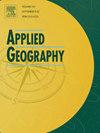无桩共享单车出行行为对新冠肺炎小爆发的时空响应研究
IF 4
2区 地球科学
Q1 GEOGRAPHY
引用次数: 0
摘要
虽然人们广泛研究了COVID-19大流行对人类流动性的影响,但小型疫情的影响仍未得到充分探讨。本研究通过调查无桩共享单车(DBS)在小规模疫情中的时空行为,解决了这一差距。首先,运用描述性统计和网络理论对不同爆发阶段的时空演化进行了分析。然后引入先知模型来评估短期反应,并引入copula理论来分析行为偏好。结果表明,与更广泛的大流行观察结果相反,在小爆发期间计数增加,持续时间缩短。虽然在疫情期间,星展活动大多局限于局部地区,但它向东扩展到更广泛的城市外围,显示出社区的合并和增长。值得注意的是,与基于网格的分析相比,网络社区揭示了不同的时空行为,为有针对性的策略提供了新的视角。随着一周内病例的增加,出行行为也有所不同:在城市核心地区,出行次数先是增加,然后下降,而在该地区超过一半的地区,出行距离和持续时间都缩短了。然而,概率模型显示,在深圳西部出现新病例后的几天里,距离更大的可能性更大,这凸显了综合分析的必要性。该研究为城市和交通规划的利益相关者提供了关于共享单车行为的多层次时空洞察。本文章由计算机程序翻译,如有差异,请以英文原文为准。
Understanding the spatiotemporal response of dockless bike-sharing travel behavior to the small outbreaks of COVID-19
While the impact of the COVID-19 pandemic on human mobility is widely studied, the effects of small outbreaks remain underexplored. This study addresses this gap by investigating spatiotemporal behaviors of dockless bike-sharing (DBS) over small outbreaks. First, descriptive statistics and network theory are applied to identify the spatiotemporal evolution across different outbreak phases. The Prophet model is then introduced to evaluate short-term responses, and the copula theory to analyze behavioral preferences. Results indicate increased count and decreased duration during small outbreaks, contrasting with broader pandemic observations. Although DBS activity is most localized during the outbreaks, it expands eastwards into wider urban peripheries, showing community merger and growth. Notably, network communities reveal distinct spatiotemporal behaviors compared to grid-based analysis, offering new perspectives for targeted strategies. Travel behaviors vary with rising cases within a week: trip count initially increases, then declines in the urban core, while trip distance and duration shorten in over half of the region. Probabilistic modeling, however, suggests that greater distances are more likely on days following new cases in western Shenzhen, highlighting the need for comprehensive analysis. This research provides multi-level spatiotemporal insights into bike-sharing behavior for stakeholders in urban and transport planning.
求助全文
通过发布文献求助,成功后即可免费获取论文全文。
去求助
来源期刊

Applied Geography
GEOGRAPHY-
CiteScore
8.00
自引率
2.00%
发文量
134
期刊介绍:
Applied Geography is a journal devoted to the publication of research which utilizes geographic approaches (human, physical, nature-society and GIScience) to resolve human problems that have a spatial dimension. These problems may be related to the assessment, management and allocation of the world physical and/or human resources. The underlying rationale of the journal is that only through a clear understanding of the relevant societal, physical, and coupled natural-humans systems can we resolve such problems. Papers are invited on any theme involving the application of geographical theory and methodology in the resolution of human problems.
 求助内容:
求助内容: 应助结果提醒方式:
应助结果提醒方式:


